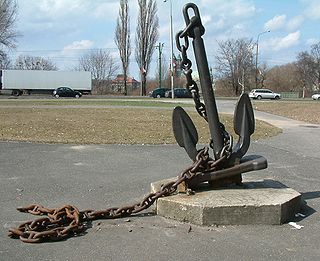
An anchor is a device, normally made of metal, used to connect a vessel to the bed of a body of water to prevent the craft from drifting due to wind or current. The word derives from Latin ancora, which itself comes from the Greek ἄγκυρα (ankura).

Rigging comprises the system of ropes, cables and chains, which support a sailing ship or sail boat's masts—standing rigging, including shrouds and stays—and which adjust the position of the vessel's sails and spars to which they are attached—the running rigging, including halyards, braces, sheets and vangs.
An overhead line or overhead wire is used to transmit electrical energy to electric trains, trolleybuses or trams. It is known variously as:

A mooring is any permanent structure to which a vessel may be secured. Examples include quays, wharfs, jetties, piers, anchor buoys, and mooring buoys. A ship is secured to a mooring to forestall free movement of the ship on the water. An anchor mooring fixes a vessel's position relative to a point on the bottom of a waterway without connecting the vessel to shore. As a verb, mooring refers to the act of attaching a vessel to a mooring.

A block and tackle or only tackle is a system of two or more pulleys with a rope or cable threaded between them, usually used to lift heavy loads.

A rope is a group of yarns, plies, fibers or strands that are twisted or braided together into a larger and stronger form. Ropes have tensile strength and so can be used for dragging and lifting. Rope is thicker and stronger than similarly constructed cord, string, and twine.

A monkey's fist or monkey paw is a type of knot, so named because it looks somewhat like a small bunched fist/paw. It is tied at the end of a rope to serve as a weight, making it easier to throw, and also as an ornamental knot. This type of weighted rope can be used as a hand-to-hand weapon, called a slungshot by sailors. It was also used in the past as an anchor in rock climbing, by stuffing it into a crack. Nowadays it is still sometimes used in sandstone, e.g., the Elbe Sandstone Mountains in Germany.

A spinnaker is a sail designed specifically for sailing off the wind from a reaching course to a downwind, i.e. with the wind 90–180° off bow. The spinnaker fills with wind and balloons out in front of the boat when it is deployed, called flying. It is constructed of lightweight fabric, usually nylon, and is often brightly coloured. It may be optimised for a particular range of wind angles, as either a reaching or a running spinnaker, by the shaping of the panels and seams.
"Two, six, heave" is a phrase used to coordinate seamen's pulling.
This is a partial glossary of nautical terms; some remain current, while many date from the 17th to 19th centuries. See also Wiktionary's nautical terms, Category:Nautical terms, and Nautical metaphors in English. See the Further reading section for additional words and references.

A derrick is a lifting device composed at minimum of one guyed mast, as in a gin pole, which may be articulated over a load by adjusting its guys. Most derricks have at least two components, either a guyed mast or self-supporting tower, and a boom hinged at its base to provide articulation, as in a stiffleg derrick.

A swing yarder is a mobile piece of heavy duty forestry equipment used for pulling logs from the woods to a logging road with cables. The swing yarder is also known as a grapple yarder.

Careening is the practice of grounding a sailing vessel at high tide, in order to expose one side of its hull for maintenance and repairs below the water line when the tide goes out.

A fly system, or theatrical rigging system, is a system of rope lines, blocks (pulleys), counterweights and related devices within a theater that enables a stage crew to fly (hoist) quickly, quietly and safely components such as curtains, lights, scenery, stage effects and, sometimes, people. Systems are typically designed to fly components between clear view of the audience and out of view, into the large opening, known as the fly loft, above the stage.

A deadeye is an item used in the standing and running rigging of traditional sailing ships. It is a smallish round thick wooden disc with one or more holes through it, perpendicular to the plane of the disc. Single and triple-hole deadeyes are most commonly seen. The three-holed blocks were called deadeyes because the position of the three holes resemble the eye and nose sockets of a sheep's skull.

An windlass is a machine used on ships that is used to let-out and heave-up equipment such as a ship's anchor or a fishing trawl. On some ships, it may be located in a specific room called the windlass room.

The junk rig, also known as the Chinese lugsail or sampan rig, is a type of sail rig in which rigid members, called battens, span the full width of the sail and extend the sail forward of the mast.

A Lyle gun is a line thrower powered by a short-barrelled cannon. It was invented by David A. Lyle and were used from the late 19th century to 1952, when they were replaced by rockets for throwing lines.
In underwater diving, a downline is a piece of substantial cordage running from a point at the surface to the underwater workplace, and kept under some tension. It can be used as a guideline for divers descending or ascending, for depth control in blue-water diving, and as a guide for transfer of tools and equipment between surface and diver by sliding them along the downline at the end of a messenger line. A shotline is a special case of downline which uses a heavy weight at the bottom and a float at the top. A jackstay is a more lateral equivalent, that commonly follows a surface, and will not usually allow materials transfer without a messenger line from the destination end.
A Jackstay is a cable or bar between two points to support and guide a load between those points, or as an anchor to attach something to be constrained along that line. The term is mostly used in a marine context and originated on sailing ships. Note the use of "stay" implies load bearing working rigging. In diving it is also a line to guide the movements of a diver between the endpoints.















